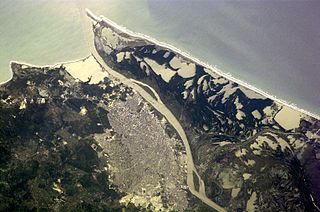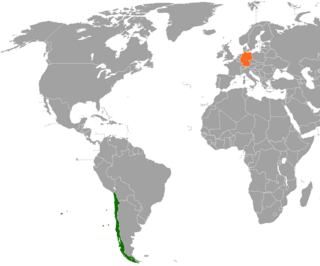
Guatemalans are people connected to the country of Guatemala. This connection may be residential, legal, historical or cultural. For most Guatemalans, several of these connections exist.
This article details the geographical distribution of speakers of the German language, regardless of the legislative status within the countries where it is spoken. In addition to the Germanosphere in Europe, German-speaking minorities are present in many other countries and on all six inhabited continents.
The history of the Jews in Latin America began with conversos who joined the Spanish and Portuguese expeditions to the continents. The Alhambra Decree of 1492 led to the mass conversion of Spain's Jews to Catholicism and the expulsion of those who refused to do so. However, the vast majority of conversos never made it to the New World and remained in Spain slowly assimilating to the dominant Catholic culture. This was due to the requirement by Spain's Blood Statutes to provide written documentation of Old Christian lineage to travel to the New World. However, the first Jews came with the first expedition of Christopher Columbus, including Rodrigo de Triana and Luis De Torres.
Isleños are the descendants of Canarian settlers and immigrants to present-day Louisiana, Puerto Rico, Texas, Cuba, the Dominican Republic, Venezuela, and other parts of the Americas. In these places, the name isleño was applied to the Canary Islanders to distinguish them from Spanish mainlanders known as "peninsulars". Formerly used for the general category of people, it now refers to the specific cultural identity of Canary Islanders or their descendants throughout Latin America and in Louisiana, where they are still called isleños. Another name for Canary Islander in English is "Canarian." In Spanish, an alternative is canario or isleño canario.

Immigration to Argentina began in several millennia BCE with the arrival of different populations from Asia to the Americas through Beringia, according to the most accepted theories, and were slowly populating the Americas. Upon arrival of the Spaniards, the native inhabitants of Argentine territory were approximately 300,000 people belonging to many Indigenous American civilizations, cultures, and tribes.

Russian Americans are Americans of full or partial Russian ancestry. The term can apply to recent Russian immigrants to the United States, as well as to those who settled in the 19th century Russian possessions in northwestern America. Russian Americans comprise the largest Eastern European and East Slavic population in the U.S., the second-largest Slavic population generally, the nineteenth-largest ancestry group overall, and the eleventh-largest from Europe.

Immigration to Mexico has been important in shaping the country's demographics. Since the early 16th century, with the arrival of the Spanish, Mexico has received immigrants from Europe, Africa, the Americas, and Asia. Today, millions of their descendants still live in Mexico and can be found working in different professions and industries.

Argentina has a racially and ethnically diverse population. The territory of what today is Argentina was first inhabited by numerous indigenous peoples. The first white settlers came during the period of Spanish colonization, beginning in the 16th century. The Spaniards imported African slaves, who would go on to become the first Afro-Argentines. Following independence from Spain in the 19th century and well into the 20th century, numerous migration waves took place, with Argentina being the second most popular destination for migrants in the early 20th century, after the United States. Most of these migrants came from Europe.

The history of immigration to Canada details the movement of people to modern-day Canada. The modern Canadian legal regime was founded in 1867, but Canada also has legal and cultural continuity with French and British colonies in North America that go back to the 17th century, and during the colonial era, immigration was a major political and economic issue with Britain and France competing to fill their colonies with loyal settlers. Until then, the land that now makes up Canada was inhabited by many distinct Indigenous peoples for thousands of years. Indigenous peoples contributed significantly to the culture and economy of the early European colonies to which was added several waves of European immigration. More recently, the source of migrants to Canada has shifted away from Europe and towards Asia and Africa. Canada's cultural identity has evolved constantly in tandem with changes in immigration patterns.

Immigration to Colombia during the early 19th and late 20th Century, is what makes it one of the most diverse countries in the world, above other countries in the Latin region. Colombia inherited from the Spanish Empire harsh rules against immigration, first in the Viceroyalty of New Granada and later in the Colombian Republic. The Constituent Assembly of Colombia and the subsequent reforms to the national constitution were much more open to the immigrants and the economic aperture. However naturalization of foreigners, with the exception of those children of Colombians born abroad, it is still difficult to acquire due 'Jus soli' law is not allowed by the government, and only 'Jus sanguinis' law is accepted. Immigration in Colombia is managed by the "Migración Colombia" agency.
Immigration to Chile has contributed to the demographics and the history of this South American nation. Chile is a country whose inhabitants are mainly of Iberian, mostly of Andalusian and Basque origin, and Native American, mostly descended from Mapuche peoples. A moderate numbers of European immigrants settled in Chile during the 19th and 20th centuries, mainly Spanish, as well as Germans, British, French, Southern Slavs, and Italians who have made additional contributions to the racial complex of Chile. However, this immigration was never in a large scale, contrasting with mass migrations that characterized Argentina, Uruguay and southern Brazil, and therefore, anthropologically, its impact with lesser consequence. At the same time, some separate cultural aspects, such as German cakes, British afternoon tea, and Italian pasta, were preserved. The fusion is also visible in the architecture of Chilean cities. This intermarriage and mixture of cultures and races have shaped the present society and culture of Chile.

The Spanish diaspora consists of Spanish people and their descendants who emigrated from Spain. In the Americas, the term may refer to those of Spanish nationality living there; "Hispanic" is usually a more appropriate term to describe the general Spanish-speaking populations of the Americas together with those in Spain. The diaspora is concentrated in places that were part of the Spanish Empire. Countries with sizeable populations are Argentina, Bolivia, Chile, Colombia, Costa Rica, Cuba, Dominican Republic, Ecuador, El Salvador, Guatemala, Honduras, Mexico, Nicaragua, Panama, Paraguay, Peru, Uruguay, Venezuela, and, to a lesser extent, Brazil, Belize, Haiti, United States, Canada, the Philippines and the rest of Europe.

The Great European Immigration Wave to Argentina was a major source of economic growth and social change for Argentina. Beginning in the late 19th century, the wave consisted largely of Italian and Spanish immigrants, though it did include other nationalities and ethnic groups, most notably a large Slavic and Jewish population. The rapid influx of European migrants led to immense population growth in Argentina, and the migrants were incredibly influential in the politics of the nation by introducing political concepts like labor unions and socialism into the country's political zeitgeist. The remnants of the Immigration Wave of migrants are still visible in Argentina today, not only as a result of their influence on the country's economic and political history, but as cultural cornerstones in both urban and rural communities alike. Shifting labor markets and decreased reliance on European economics after the outbreak of World War I had a huge effect on European Migration to Argentina. These factors all lead to the end of the Great European Immigration Wave and began an era of Latin American politics primarily focused on domestic growth rather than the outsourcing of international labor.

German-Chilean relations are foreign relations between Germany and Chile. Around 12,300 kilometers separate Chile and Germany but both nations still share a wide range of bilateral relations. Over the course of the last 150 years many Germans have settled in Chile for several different reasons. Migrating in the opposite direction, several thousand Chileans sought refuge in Germany during Pinochet's dictatorship.

Italian Guatemalans are Guatemalan-born citizens who are fully or partially of Italian descent, whose ancestors were Italians who emigrated to Guatemala during the Italian diaspora, or Italian-born people in Guatemala. Italians contributed in the construction of the country as monuments, parks and besides contributing at the National Conservatory.
A German Guatemalan is a citizen of Guatemala whose ancestors were German settlers who arrived in the 19th and 20th century. Guatemala had a massive immigration of Germans in the nineteenth century. The government of Justo Rufino Barrios provided them with farmlands for coffee in the departments of Quetzaltenango, Alta Verapaz and Baja Verapaz, and by the early 20th century Germans populated Guatemala City, Zacapa and Jutiapa. Guatemala currently has a strong community of Germans who make up the majority of European immigrants in the country, and it is also the most numerous German community in all Central American countries.
A German Salvadoran is a Salvadoran descendant of German citizens who have adopted the two nationalities or Salvadorans who have German ancestry, there is a record of waves of German immigrants since the 19th century, later with the arrival of German refugees during the Second World War. El Salvador has important relations with Germany
Immigration in Guatemala constitutes less than 1%, approximately 140,000 people, and most come from neighboring countries. Guatemala's historic ethnic composition is mostly immigrant stock from Europe and as well as Asian and Africans brought during the era of slavery. Currently, the composition of Guatemala consists mostly of mestizos, Amerindians and Europeans, and to a lesser extent, Garifuna. In recent decades, immigration to Guatemala has led to an increase in desire for more businesses and tourist attractions, after there had been a considerable drop from 1950 to 1980.

Americans in Guatemala refers to the arrival of United States citizens who have settled in Guatemala.

Arab immigration to the Republic of Honduras began in the 19th century with the liberal reforms of President Marco Aurelio Soto (1876–1883), who saw immigration as a determining factor in the development of capitalism in Central America, and sought to establish an attractive environment for foreign investment. The largest Arab community in Honduras is the people of Palestinian descent, the majority of whom (95%) are Christian. The approximate population of Honduran Arabs is more than 300,000 people, arround 280,000 Palestinians and 20,000 Lebanese, estimates place the Muslim population at about 11,000.










